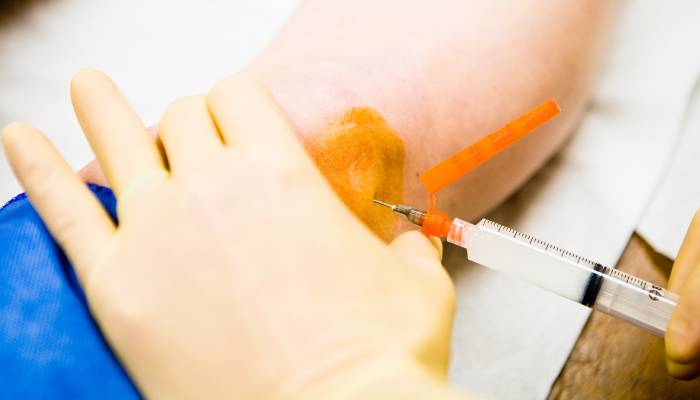
Cortisone injections are a common and effective treatment for joint pain and inflammation. They are commonly used for conditions such as bursitis, tendonitis, and arthritis. It is a steroid medication that is injected directly into the joint to reduce inflammation and relieve pain. The injections also help to improve mobility in the affected area. However, it is important to discuss the potential benefits and drawbacks of cortisone Injection for joint pain with your doctor before undergoing the injection.
Cortisone shots are used to treat a variety of conditions, including:
- Osteoarthritis[1] : Besides cortisone, rooster comb injections are also effective alternative for osteoarthritis patients.
- Rheumatoid arthritis
- Bursitis
- Tendonitis
- Back pain
- Gout
- Plantar fasciitis
- Carpal tunnel syndrome
- Psoriatic arthritis
- Shoulder impingement syndrome
- Trigger finger
Advantages:
Cortisone injections can bring significant relief. They work by reducing inflammation in the joint and reducing the pain associated with it. The medication is injected directly into the joint, where it can reduce inflammation and swelling quickly. This can lead to a rapid reduction in pain and improved mobility.
In this case, the injections can reduce inflammation and slow down the progression of the disease. These injections can also be used to treat other conditions such as carpal tunnel syndrome and tennis elbow.
In short, the advantages of cortisone injections for joint pain include:
- Fast Relief: Cortisone injections can provide fast relief from joint pain. The effects of the injection can be felt within hours after the injection, and can last for several weeks.
- Long-Term Relief: Cortisone injections can provide long-term relief from joint pain. This is because the medication is slowly released over time, allowing the joint to heal and the pain to subside.
- Cost-Effective: Cortisone injections are relatively inexpensive compared to other forms of treatment. They are also less invasive than surgery, making them a more cost-effective option.
- Side Effects: Cortisone injections have minimal side effects, with the most common being a temporary soreness at the injection site. Other side effects can include lightheadedness or nausea.
- Non-Invasive: Cortisone injections are done through a simple injection, which means there is no surgery or incision required. This makes the procedure less invasive and less risky than some other forms of treatment.
If you are suffering from joint pain, talk to your doctor about the possibility of using cortisone injections as a treatment option.
Drawbacks of Cortisone injections
Cortisone injections are a common treatment for joint pain, but they may also come with various drawbacks.
- Temporary flare in pain and inflammation: These injections can temporarily increase joint pain. This is because the cortisone can irritate the joint and cause further inflammation. As a result, the joint may become temporarily more painful after the injection.
- Repeated shots might damage the cartilage within a joint: It can also weaken the joint over time. This is because the cortisone can weaken the joint’s collagen, which is the main supportive structure of the joint. As the collagen weakens, the joint can become more prone to injury and further damage.
- Promote the development of infection: They can also cause infection. The injection site can become infected if bacteria enters the joint. This can lead to further joint damage and pain.
- Injections of steroids may cause the skin and fat beneath the skin to thin: In addition, cortisone injections can also cause thinning of the skin around the injection site. This can lead to bruising and other skin problems.
- Cortisol injections can also result in steroid-induced osteoporosis: They can also cause steroid-induced osteoporosis. This is because the cortisone can reduce the body’s ability to absorb calcium, leading to weakened bones and an increased risk of fractures.
Overall, cortisone injections can be an effective treatment for joint pain, but they also come with potential risks and side effects. It is important to discuss the pros and cons of cortisone injections with your doctor before proceeding with treatment.
Length of the effect of a cortisone shot
The effects of a cortisone shot can vary depending on the individual and the condition being treated. In general, the effects of a cortisone shot can last anywhere from a few days to several weeks. For some conditions, more than one cortisone shot may be required to achieve the desired results. In addition, for conditions that require ongoing treatment, follow-up shots may be necessary.
The effects of a cortisone shot are typically most noticeable within the first few days after the injection. These effects may include a decrease in pain, swelling, and inflammation. Depending on the condition being treated, additional relief may be seen over the course of a few weeks.
Who should not take cortisone shots ?
Cortisone shots are not suitable with certain medical conditions such as diabetes, as the drug, can affect blood sugar levels. People with high blood pressure, heart disease, or a weakened immune system should also avoid the shots, as they can cause serious and even life-threatening reactions. Pregnant women should not take cortisone shots, as the drug can have adverse effects on the fetus.
Additionally, people with active infections should not take cortisone shots, as it can worsen the infection or cause other complications. People with allergies or sensitivities to cortisone should also avoid this treatment. Lastly, people taking certain medications should not take cortisone shots, as it can cause adverse drug interactions. Before taking cortisone shots, individuals should consult with their doctor to ensure that it is safe for them.
Final Conclusion:
Taking a cortisone injection for joint pain is a decision that should be made after careful consideration. Cortisone injections can provide relief from pain and inflammation, but they are not without risks. Additionally, cortisone injections may provide only temporary relief and may need to be repeated for ongoing relief. It is important to discuss the pros and cons of a cortisone injection with a doctor before making a decision. Ultimately, it is important to weigh the risks and benefits of a cortisone injection before making a decision.

Lifebing is driven by an unrelenting passion for promoting health and well-being, our team is wholly committed to curating exceptional content and immersive experiences.
